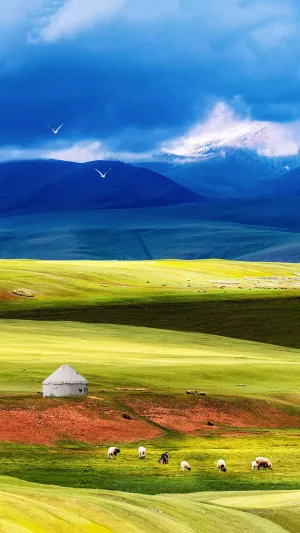Although the land area in the world is not comparable to the area of the ocean, it is also very vast, after all, it has to accommodate so many people in the world. There are not only dense jungles on the land, but also vast areas of land, where many cattle and sheep live leisurely and easily. Of course, each grassland has different characteristics. Next, let's take a look at the wonders of the world's major grasslands.
Eurasian steppe
There is such a grassland, which is so wide that it spans four plains, that is, the Eurasian steppe, because of its vast area, it spans nearly one continent. Due to the variable ecological environment and differences in geographical environment, this grassland can be divided into three sub-regions. The fauna system on the grassland is very rich, with rich vegetation and a small number of natural enemies, so rodents thrive here very quickly.
The Eurasian steppe area is not only the largest and most important area on earth, but also the best-preserved steppe area at present. According to geographic data, during the Miocene period 23 million years ago, grassland landscapes already existed in Eurasia, and the area gradually expanded about 2.6 million years ago. It was not until 100,000 years ago that the current grassland type was formed.
New zealand ranch
The beauty of the grasslands in New Zealand pastures is comparable to the world in fairy tales. This is the world's premier golden pasture, which has always retained its original appearance. The clean air and pure water here, as well as the mild climate in all seasons, make it world famous.
The locals like to play with their families on the ranch during holidays or weekends. Groups of cows can be seen lazily basking in the sun from time to time on the ups and downs of the hillside. Occasionally, some shepherds can be seen lying next to the cows, enjoying sunbathing and resting. It makes people reluctant to leave because of the more leisurely life here.
Serengeti
The Serengeti savannah is a paradise for wildlife. It is home to the world's most diverse and largest wild fauna, with about 70 large mammals and 500 endemic birds. The semi-annual migration of large animals is one of the top ten natural tourism wonders in the world. From May to June each year, about 2.1 million herbivores migrate from the central plains to the perennial water areas in the west, which is spectacular.
Pampas
The pampas grassland, also known as the South American grassland or the Argentine grassland, is a subtropical prairie located in the southern part of South America, in the middle and eastern part of Argentina. The pampas reach the foothills of the Andes in the west and the Atlantic coast in the east. The Pampas grassland is an alpine grassland in the humid subtropical climate of South America, covering an area of about 760,000 square kilometers.
The rolling grassland is endless, and the natural light and shadow formed by the deep and shallow green will make you feel like you are in the beautiful canvas of nature.





